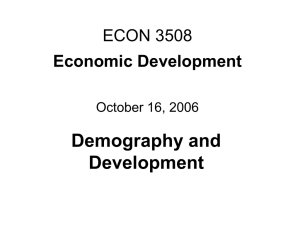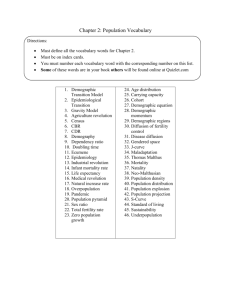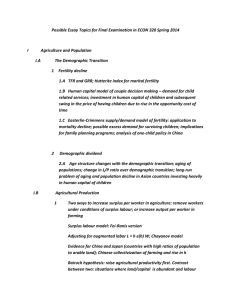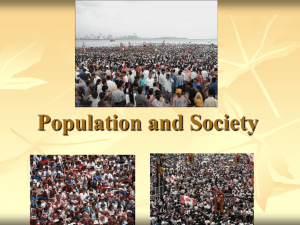5. Demography and Development (Text, Chapter 6)
advertisement
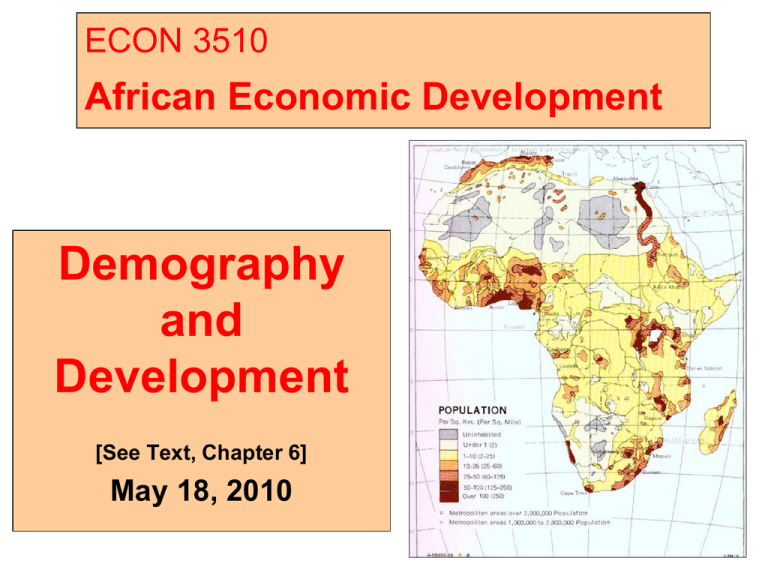
ECON 3510 African Economic Development Demography and Development [See Text, Chapter 6] May 18, 2010 Agenda I. Theories of Population in the African Context 1. Malthus Theory and Demographic History 2. The Demographic Transformation 3. Microeconomic Theory of Population II. African Demographic Experience III. Note on Demographic Structures IV. Implications of Rapid Population Growth for African Economic Development V. Population Policies 1. Malthus Theory of Population Growth: - people had an uncontrollable urge to procreate! [This would not diminish as civilization progressed.] - population growth would continue at a rapid pace (“geometrically”) - Agriculture was subject to limited land and diminishing returns. (“arithmetic”) - population would expand to the point where the “positive checks” would operate. Famine, Disease and War. Result: incomes would fall to the starvation level. Life would be “nasty, brutish and short” for the vast majority of human beings. Is this or was this in fact the case? World Population An Economic History of the World! (courtesy of G. Clark, A Farewell to Alms) Real Output per Worker in England, 1260-1960. (G.Clark) Was there any escape from this fate? Was there any escape from this fate? Malthus’ Recommendation: Establish “Preventative Checks” on population: - “Moral Restraint,” - Delay of marriage How probable were these ? Was Malthus’ Vision Correct? In general maybe “No” • • at least for recent centuries though some parts of the world maybe caught in a “Malthusian Population Trap.” Why or Why Not? Malthus’ predictions: unfulfilled for high & medium income countries: 1. Technology of contraception was unforeseen; 2. Family Planning; 3. Technological change has postponed the impacts of serious diminishing returns; agricultural output has in fact grown more rapidly than population. Why? 4. Has the “urge to procreate” declined? 5. Social and sociological impacts of “Modernization” and Urbanization on birth rates were unforeseen: - Higher female labour force participation; - Higher status for women: increases education and reduces child-bearing - Higher costs of raising children in modern urban areas vis-à-vis agriculture and rural areas - Cultural factors: more Television etc. etc. - Less need for children as family labour and old age security; Can Rapid Population Growth be Positive? Esther Boserup: Yes Population growth greater population density innovation & productivity; economies of scale better support for infrastructure Simon: Short term results likely negative Long term results, may be positive Was Malthus’ Vision Correct for “Africa”? Are (some of) the Countries of Africa Approaching a Malthusian Trap? Why or Why Not? Some Comparative Demographic Information Country Size (square kms.) Population Population Population Density Growth (Millions, 2005) (persons per Rate Fertility Rate square km., 2001) (per cent) per Woman) 2.2 2.0 2.2 6.8 5.7 6.1 Burundi Rwanda Malawi 28,000 26,000 118,000 7.9 9.2 13.2 282 354 112 Nova Scotia New Brunswick 55,000 0.913 17 73,000 0.730 10 (Children II. Theory of the Demographic Transition (See Charts below) Stage 1: High Birth Rate and Death rate Population stability Stage 2: Falling death Rate; Continuing High Birth Rate: Population increasing faster and faster; Stage 3: Death Rate Decline Intensifies; Birth Rate Decline accelerates; Population Growth continues but decelerates Stage 4: Low Death Rate and Low Birth Date: Population Stability To which I would add Stage 5: The Current Reality for High Income Countries? Death Rates Continue at a low level; Birth Rates fall further Population Size Declines www.ldeo.columbia.edu/edu/dees/V1003/imagres/demographic .transition2 Stage 5, Explaining the Demographic Transition Factors Affecting Death Rates: Factors Affecting Birth Rates: Usefulness of Approach III. The Microeconomic Theory of Fertility Application of basic microeconomic theory to the childbearing decision. Assumption: children are at least in part a good like others, providing “consumption” benefits to the parents and serving also as an investment good (providing labour and generating family income) Possible economic benefits of additional children: Old-age security Expected income from child labour Costs of additional children: Opportunity cost of Mothers’ time Opportunity and actual costs of educating, & looking after children How to reduce fertility rates? Change the costs and the benefits! How? Why do African Fertility Rates Remain High? Some Demographic Indicators, Africa 2000-2005 Total Fertility Rate Population Growth Rate Working Age Population (15-64) Africa 4.7 2.3 56.4 Ethiopia Kenya 5.3 5.0 2.5 2.6 53.2 50.7 Liberia Mauritius Somalia Uganda Zambia 6.8 1.9 6.0 5.2 3.2 4.2 0.8 3.0 3.1 1.9 50.7 69.7 53.1 58.0 56.4 Why do African Fertility Rates Remain High? • • • • • • • • Children as family labour force; Intergenerational wealth transfers Children as old age security; Religion? Rural character of society Impacts of urbanization Pervasiveness of electricity and consumer stuff Education for women: age of marriage and opportunity costs of having children • Presence of contraception and abortion Hans Rosling on Statistics, Demography and Poverty • http://www.ted.com/index.php/talks/hans_rosling_reveals_new_insights_ on_poverty.html As a doctor and researcher, Hans Rosling identified a new paralytic disease induced by hunger in rural Africa. Now the global health professor is looking at the bigger picture, increasing our understanding of social and economic development with the remarkable trend-revealing software he created. IV. A Note on Demographic Structures: See: http://www.census.gov/ipc/www/idbpyr.ht ml African Countries: e.g. Kenya Rwanda High Income Countries: e.g. Japan Canada The Chinese Case: Explain the “Demographic Window of Opportunity” • Note the prospective “Aging Population” phenomenon and reductions in the relative size of the labour force V. Implications of Rapid Population Growth for African Economic Development What are they? V. Implications of Rapid Population Growth for African Economic Development 1. Impact on Income per Capita: When population is growing rapidly, economic growth must grow exceed Population Growth Rates to maintain income per capita. i.e. income per capita = income/population 2. Effects on Savings Rapid population growth tends to increase family and national consumption , thereby reducing savings 3. Investment Rapid population growth requires that large amounts of resources must be devoted to investments, to keep up with Population. Growth. 4. “Dependency” ratios: Rapid population growth leads to “bottom heavy” population pyramids, which means the working age population of a country is relatively small as a % of total population., or a high dependency ratio 5. Effects on Employment and Unemployment: Ever-growing cohorts of young people are entering the job market, adding to labour supply. Can the demand for labour demand keep up?. 6. Impacts on Income Distribution: Because family size is highest among the poor, rapid population growth affects income distribution negatively. – The numerous children of the poor have less monetary, family or parental investment in their upbringing – They start off in life with minimal inheritances. 7. Environmental Impacts Population growth in many places results in poor rural people being pushed into ever more marginal and environmentallyinappropriate farm lands. Urban environmental strtesses with rapid urbanization 8. Rapid Urbanization Urbanization in Africa: Some Indicators Country Urban Population, millions 1990 2007 Urban Population % of Total 1990 2007 Rate of Urbanization % per year, 1990-2007 Acces to Improved Sanitation, 1990 2007 Ghana 5.7 11.2 36 49 4.2 11 15 Kenya 4.3 8.0 18 21 3.7 18 19 Mauritius 0.5 0.5 44 42 0.8 95 95 Nigeria 33.3 70.5 35 48 4.4 22 25 Somalia 2.0 3.1 30 36 2.7 na na S. Africa 18.3 28.8 52 60 2.7 Tanzania 4.8 10.1 19 25 4.4 29 31 144.3 287.1 28 36 4.0 20 24 Sub-Saharan Africa, Total 51 Source: World Bank, World Development Indicators, 2009 Table 3.11 VI. Population Policies Should governments pursue active population control policies ? Should Governments wait for the “Demographic Transition” to occur automatically? i.e. Does “Development” lead to Population Stability? This has been controversial, for various reasons Types of Programs: 1. Internal Migration? A few countries have tried to relieve population pressures in some areas by migration to other under-populated areas (Amazonia in Brazil; the outer islands in Indonesia.) Potential for Africa?. 2. International Migration? The annual population increase in Africa (about 23 million) is too large to be relieved significantly via international migration. Is this correct? 3. Constructing a policy environment promoting greater desire for smaller families Governments can change the environment in which families decide to have children - by designing programs and policies that will induce parents to choose to have fewer children and reduce family size. Of special importance are – policies enhancing the status of women – promoting education in general and especially for girls – promoting breast-feeding, – reducing child labour – promoting higher labour force participation rates for women – improving social security and pensions (so fewer children are necessary to look after their aged parents) Also: - promoting contraceptive use - legalizing abortion? 4. Specific Family Planning Programs: Promote Family Planning • If families want large families in any case (for family labour purposes, for old-age security, etc.) - they may not be interested in family planning facilities even if they are available. • If families want smaller families due to the types of factors mentioned above: - then making family planning facilities available can have an important impact. - Integrate family planning with maternal and early child care? Fertility Rates, Africa 1900-2007 Fertility Rate 1990 Fertility Rate 2007 Population Growth Rate Africa 6.3 5.1 2.3 Ethiopia Kenya 6.8 5.8 5.3 5.0 2.5 2.6 Liberia Mauritius Nigeria Somalia Uganda Zambia 6.9 2.3 6.7 6.8 7.1 6.4 5.2 1.7 5.3 6.0 6.7 5.2 4.2 0.8 2.1 3.0 3.1 1.9
